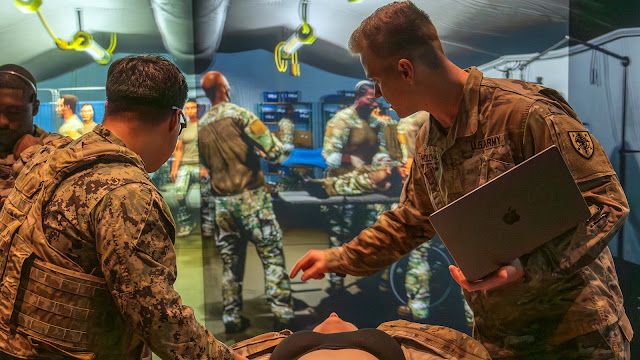USU Medical Students Become Ultrasound Instructors for Summer Experience
Uniformed Services University students revive the Operational Ultrasound program for their Summer Operational Experience to gain the opportunity to teach peers
September 5, 2023 by Ian Neligh
Sometimes the best way to learn is by teaching.
Medical school students attending the Uniformed Services University of the Health Sciences (USU) put this idea to the test during their Summer Operational Experience (SOE) this year.
The SOE provides a unique opportunity for students to select an optional training from a host of choices such as the Army’s Air Assault School or enhanced training from sites such as the Joint Special Operations Medical Training Center.
This summer a handful of students decided to revive a previous USU program called Operational Ultrasound and then build a curriculum to teach to 20 of their peers.
Air Force Col. (Dr.) Cynthia Shen, assistant professor in the Department of Military and Emergency Medicine and the faculty sponsor, says in past years students could take a robust ultrasound summer operational experience while traveling to Honduras and working in one of the hospitals there.
“All of that kind of fell by the wayside with COVID-19,” says Shen. “They stopped traveling and the program kind of just dwindled a little. So, this year the students came back and said, ‘Hey, we really want to do this. How do we go about it?’”
Army 2nd Lt. Rebecca Beard, a second-year medical student says she wanted to revive the program because she believes ultrasound is an incredibly helpful and versatile tool for a deployed physician to use in austere environments.
“My end goal has always been to provide the best care that I can for our warfighters, and I believe that knowing how to use all of the tools at our disposal is a key element of that goal,” says Beard. “I saw that USU previously had a program to teach Operational Ultrasound, but it was discontinued. When I saw there was considerable interest among my peers for an Operational Ultrasound Summer Operational Experience, I decided to pursue developing (one) and modeling it after the previous course.”
Beard says because they did not have access to the previous program’s materials, they had to develop this version from the ground up. She adds she would not have been able to propose the creation of this program without the support of Col. Shen, faculty advisors and classmates.
“Their support early in the proposal and development of this program enabled us to develop a structure and curriculum that is sustainable and beneficial for medical students, corpsmen and medics for years to come,” Beard says.
The students traveled to Brooke Army Medical Center in San Antonio for two weeks where they received hands-on training in working with patients using portable ultrasound. During the third week of their SOE, they returned to the university and implemented a course for about 20 other students.
“They did it all, they made a curriculum, they wrote lectures, they figured out what they wanted to teach, and how they wanted to teach,” says Shen. “They wrote a written exam, and then they wrote a practical exam.”
Shen says the goal was to learn the skills and have the knowledge base, and then be able to teach not only their peers, but their medic cohort as well.
“It was unique in the sense that it was completely student run,” Shen says. “Now, of course, I gave them a little guidance here and there and made sure they were on the right page… But beyond that, I really let them go and let them do their own thing.”
Shen says while peer instruction is not rare in medical school, it is unique for the students to get the chance to create their own curriculum.
The course’s final was held at USU’s Val G. Hemming Simulation Center which uses technology and special effects to train students in a realistic virtual environment.
“It is the next best thing to actually being ‘down range’ and giving them a little bit of stress,” Shen says.
Army medical student 2nd Lt. Ha Eun Kim says she had opportunities to be exposed to the ultrasound machine during her first year of medical school but was interested in getting a better understanding, so she signed up for the operational experience.
“Ultrasound is especially important for military physicians since military doctors are expected to be ‘stand-alone physicians’ and perform out of their comfort zone, whether they are primary care doctors, emergency physicians, or surgeons,” says Kim. “I wanted to develop this skill during pre-clerkship so that I will be able to be helpful during my clerkship rotations and become a well-rounded physician regardless of the specialty I choose in the future.”
Army 2nd Lt. David Holovac says he volunteered to participate in the course because ultrasound, as an imaging modality and diagnostic tool, is becoming more widespread across clinical practice.
“Ultrasonography is typically praised for its safety, affordability and availability in the clinical setting,” Holovac says. “However, as military physicians, deployments in future combat operations may limit the availability of more traditional imaging modalities and thus having a strong foundation and understanding of ultrasonography was important to me in my career aspirations.”
Holovac adds that because he’s also interested in later pursuing academic medicine and a future teaching position, the experience also allowed him to get some hands-on experience in that realm.
Army 2nd Lt Sabreenah Khan said for her the teaching portion of the operational ultrasound SOE was a great way to synthesize the knowledge they gained from the emergency physicians trained in ultrasound.
“Answering questions from the students was also a great way to test our knowledge on the different modalities we taught and helped highlight areas that could use further clarification,” says Khan. “The leadership and other students helped to make the experience fulfilling and educationally worthwhile.”




